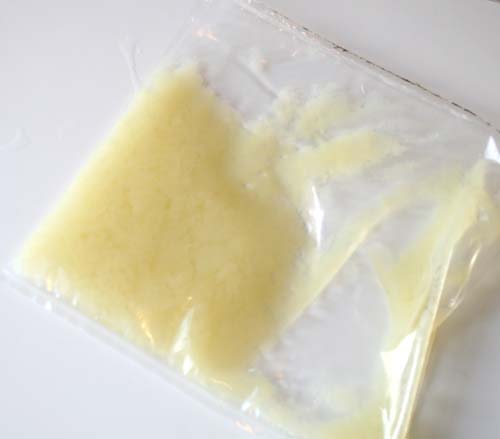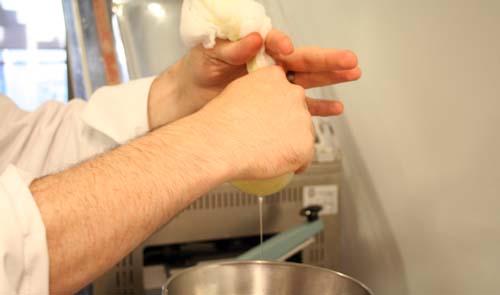posted by Dave Arnold
Aki and Alex from Ideas in Food have hit on a major breakthrough on clarification: the use of a vacuum machine to get clarified liquid from agar gels. Occasionally, I see ideas so good I’m pissed I didn’t think of them myself. This is one of those. Everyone who reads our blog probably reads theirs but I figured this idea was important enough to post on anyway.
Regular gel clarification, whether by gelatin or agar, involves freezing a gel and slowly thawing it. The freezing breaks the gel so that as it thaws, it weeps out clear liquid while holding back the cloudy parts. This process takes time (a day or two). In our post on spin gel clarification we described a technique for quickly clarifying liquids (lime juice) without freezing using agar and a centrifuge. The problem with that technique is that it requires a centrifuge. Alex and Aki simply put the gel in a vacuum bag to get the same result making the process much more widely available.Â
With most products, the length of time it takes to clarify something isn’t much of a concern. With a couple of products, time is crucial. Anyone who knows us knows we love clarified lime juice. Lime juice becomes an awful tasting mess by the time it freezes and thaws. The vacuum technique performed miraculously well on lime juice. We took 589 grams of lime juice plus 161 grams of water and got a surprising 423 grams of clarified lime juice in under an hour (the water didn’t make the clarified juice taste watered down). Here is the procedure we used:
589 grams fresh room temperature lime juice (don’t worry about the particular amount, its just what we had)
161 grams cold water (again, the numbers aren’t important, just make sure the water weight is about one fourth the weight of the lime juice. We chose 161 grams  so the total weight of water plus lime juice would be 750 grams for ease of calculation)
1.5 grams Telephone brand Agar (0.2% of the total weight of lime juice plus water)
Whisk the agar into the cold water and then heat the water while stirring until it boils, then continue to simmer for several minutes to insure proper hydration of the agar. Turn the heat off and while vigorously whisking, slowly add the lime juice to the water. This is the important step in the process. If the lime juice itself is boiled with the agar it will taste bad. If the temperature of the water-lime juice mixture drops below 35° Celsius while you are mixing, it can pre-gel and ruin your result. That’s why we chose about 4 parts room temp juice (not cold juice) to one part boiling agar + water. After the two liquids are mixed together, the temperature will be about 35-40° C. Let the lime juice gel set in an ice bath.

Once the gel is completely set (it will be very soft and will break apart under its own weight), put it in a vacuum bag and seal it with as high a vacuum as you can muster. Without re-opening the bag, Apply the vacuum again till the bag inflates then release the vacuum. Do this a bunch of times (we did 6).

Pour the whole sloppy mess into a cheesecloth over a chinois. The clear lime juice will strain out. Don’t squeeze too hard or you will squeeze a whole bunch of agar into your juice. After a while you can throw the cheesecloth back into a vacuum bag and hit it with the vacuum a couple more times.

The lime juice you have will be perfectly clear, but will have some tiny bits of floating agar. Filter these bits out with a coffee filter and you are done.

I like this technique so much I probably won’t use my centrifuge for gel clarification anymore (I’ll still use if for enzyme clarification, of course, because the yield is so high).
 I had a new spin-gel clarification technique I was going to post, but in light of this new technique, I’ll rework my idea and post tommorow.

That’s one of those things that makes so much sense it hurts! Awesome gonna try it tmrw!
I too, have been tripping since reading the IdeasInFood article (thanks to Alex and Aki for a string of very generous posts lately). Technically I am still on vacation and haven’t had access to a vacuum sealer, but I am wondering if the bag is necessary. Is it the compression of the bag that forces the syneresis or the vacuum ‘boiling’ of the gel?
The obviousness of this is a brick in the face. We’ve made gel noodles that were prone to syneresis (agar, LBG, xan) and worked our presentations to include the flavorful clear liquid that leaked out… but somehow the forced syneresis clarification eluded us… damn!
Chad. We are on the same track. See the post I just put up.
Sweet!! I will try this today.
Did anyone try forming the gel and then just beating the heck out of it before using regular old filtering?
Hey Adam. A lot of us had the same idea at once. Check out today’s post.
Thank GOD for this breakthrough. Every morning I have a glass of orange juice, and even though I always buy the pulp-free kind, I have always felt like there was something missing…or maybe not enough missing. Either way, clear liquids are superior in all ways to their cloudy brethren…clearly.
A Huge reason to try and get a vac machine…
does this method work dairy, milk, cream etc……
I don’t know. I haven’t tried it yet. Tell me what happens.
Hi,
Just wanted to point you to a forum post from 2007 with the first (to the best of my knowledge) mention of agar filtration/clarification:
http://foros.chefuri.net/viewtopic.php?p=36649
(it’s all in spanish, but in the first post there is a link to a google translation of the post)
Gelatin filtration was invented by the German Prof. Gerd Klock whereas from what I can see, agar filtration was first done by the user “Mascarpone”.
Hello Martin,
Thanks for the pointer. I was wondering who was the first person to start using agar. I heard about it from some cooks at Alinea. The question isn’t just agar, however, its using agar and not freezing! What’s nuts is that we had all been freezing Agar gels and didn’t need to. What’s even crazier is that I had been clarifying unfrozen agar by spinning in a centrifuge and didn’t think to see if the centrifuge was necessary. Then Alex and Aki did it in a vacuum machine. Turns out you don’t need anything.
Yes – there’s no need to freeze. Your 3 o’clock at night post was amusing to read!
I think the reason for this is that agar forms a very porous gel. I quote:
“Agar is known to form a very porous gel and the pore size can be roughly measured by assessing the size of particulates that are excluded from the gel in a gel permeation experiment. It has been shown that agar gels can allow molecules up to 30M daltons in size to percolate through it structure. An agar gel as the unusual property of behaving like a sponge. An agar gel of a particular shape can be dried and upon rehydration it will swell to its original size and shape.”
(http://www.cybercolloids.net/library/agar/properties.php)
I wonder if the freezing of gelatin gels lets the ice crystals penetrate the gelatin network and thereby create a sponge (a little similar to the agar gel) that allows the liquids to sip out?